The Art|Sci Center at University of California, Los Angeles, organizes a ‘Body Art Disease’-symposium on 6 November, featuring presentations, exhibitions, installations, roundtables, social gatherings, curated talk, and tours in the vaults of UCLA’s Special Collections. Participants include a number of interesting and creative people: Philip Beesley (University of Waterloo), Jill Scott (The Neurobiological Lab at the Institute of Zoology, University of Zürich), Phillip Warnell (Warwick University, UK), Susan Kozel (SMARTlab Digital Media Institute at the University of East London), Barbara Drucker (Art, UCLA), AJ Willcocks (Australia), Virocode (Peter D’Auria and Andrea Mancuso) and Caitlin Berrigan (MIT). More info here.
MR-neuroimaging and other methods for studying brain function have been used for some time now to provide criminal defence evidence in courtrooms, at least in the US. But how does neurowiring relate to classical judicial concepts like ‘intent’ and ‘responsiblity’? Can neuroscience offer excuses for criminal activity? The Triple Helix Cambridge (www.camtriplehelix.com) organizes a debate about recent adances in neuroscience and the law, next Tuesday, 21 October. Raymond Tallis, Nikolas Rose (BIOS Centre, LSE) and Ian Treasaden (Forensic Neuroscience, Imperial College) will give short presentations followed by questions from and discussions with the floor. More on Facebook here.
 On 11-12 December, the Postgraduate Forum on Genetics and Society — set up ten years ago to “bring together researchers interested in how biosciences and society(s) intersect” — organizes a colloquium at Lancaster University on the theme ‘Social and biosciences – a critical collaboration’. Keynote speech from Steve Sturdy (Genomics Forum Deputy Director), panel session with Richard Tutton (Lancaster), Niall Scott (Uclan) and Adam Hedgecoe (Sussex), and presentations by Paul Oldham and Dita Wickins-Drazilova (both Lancaster). They’re expecting student presentations too (deadline for abstracts is 7 November). Read more about the Forum and the December meeting here: http://www.pfgs.org/.
On 11-12 December, the Postgraduate Forum on Genetics and Society — set up ten years ago to “bring together researchers interested in how biosciences and society(s) intersect” — organizes a colloquium at Lancaster University on the theme ‘Social and biosciences – a critical collaboration’. Keynote speech from Steve Sturdy (Genomics Forum Deputy Director), panel session with Richard Tutton (Lancaster), Niall Scott (Uclan) and Adam Hedgecoe (Sussex), and presentations by Paul Oldham and Dita Wickins-Drazilova (both Lancaster). They’re expecting student presentations too (deadline for abstracts is 7 November). Read more about the Forum and the December meeting here: http://www.pfgs.org/.
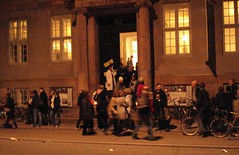 As usual, and as announced earlier, Medical Museion took part in the Copenhagen Night of Culture (Kulturnatten) — a mid-October Friday each year when hundreds of museums, galleries and other institutions in the inner city area are open all evening.
As usual, and as announced earlier, Medical Museion took part in the Copenhagen Night of Culture (Kulturnatten) — a mid-October Friday each year when hundreds of museums, galleries and other institutions in the inner city area are open all evening.
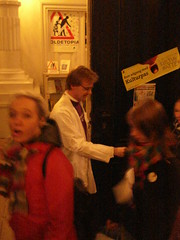 We didn’t have as many visitors as we use to have — ‘only’ slightly above 2000 passed through the doors during the six opening hours. We were not alone, however. This year’s Night of Culture was as a whole not as well-attended as in earlier years, for whatever reason. (Actually 2000+ visitors is much better both for us and our guests; it gives an opportunity to speak with at least a few individuals, and queuing isn’t a killer as it has sometimes been).
We didn’t have as many visitors as we use to have — ‘only’ slightly above 2000 passed through the doors during the six opening hours. We were not alone, however. This year’s Night of Culture was as a whole not as well-attended as in earlier years, for whatever reason. (Actually 2000+ visitors is much better both for us and our guests; it gives an opportunity to speak with at least a few individuals, and queuing isn’t a killer as it has sometimes been).
Here’s our administrator, Carsten, distributing visitor’s programmes.
 We had invited two choirs to perform in the old anatomical theatre — here’s Vokalgruppen Kolorit led by Niels Græsholm:
We had invited two choirs to perform in the old anatomical theatre — here’s Vokalgruppen Kolorit led by Niels Græsholm:
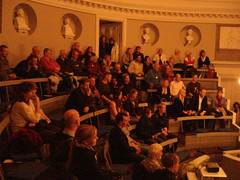
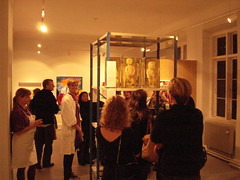 Together with one of our student guides (Sune), our conservators, Ion and Nicole, had express-built an ingeniously simple, yet very functional, storage case for some of our precious anatomical artefacts (wet specimens on the top):
Together with one of our student guides (Sune), our conservators, Ion and Nicole, had express-built an ingeniously simple, yet very functional, storage case for some of our precious anatomical artefacts (wet specimens on the top):
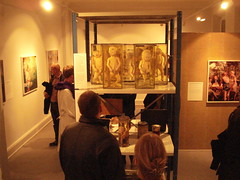
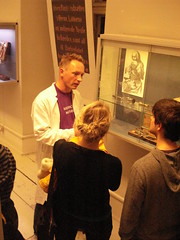 As usual, our staff was spread out all over the house. Here Søren explains 18th century surgical practices
As usual, our staff was spread out all over the house. Here Søren explains 18th century surgical practices
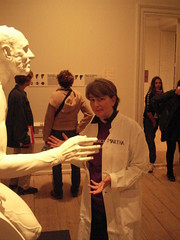 and here Martha measures her hands against those of Seneca in the ‘Oldetopia’ temporary exhibition.
and here Martha measures her hands against those of Seneca in the ‘Oldetopia’ temporary exhibition.
Like last year, the Director of Danmarks Lungeforening, Charlotte Fuglsang and her staff did their best to test as many visitors as possible for chronic obstructive pulmonary disease (often a result of the filthy habit of smoking):
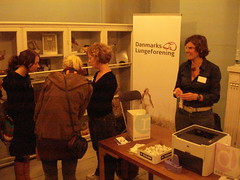
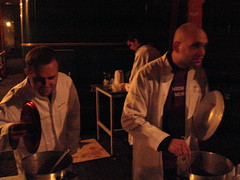
while the Glühwein crew (Thomas, Bjørn and Niels Christian) did their best to sabotage Danish public health by seducing bypassers to the dangerous habit of alcohol consumption,
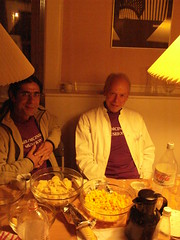 and Emil and Sven Erik resorted to the even more dangerous habit of consuming large amounts of crisps during a short break in the staff kitchen.
and Emil and Sven Erik resorted to the even more dangerous habit of consuming large amounts of crisps during a short break in the staff kitchen.
Here our technician, Folke, guides people in the right direction:
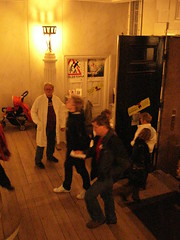
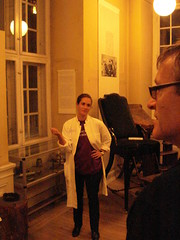
One of our student guides, Ditte, explains the history of epidemic diseases to visitors:
while Jonas tells dramatic stories about 19th century miasmas:
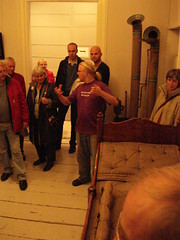
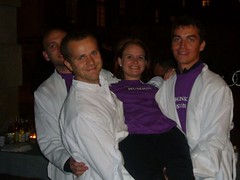 And finally, in the hands of the Glühwein crew: Monica, our administrative assistant, who did a marvellous job planning the whole operation:
And finally, in the hands of the Glühwein crew: Monica, our administrative assistant, who did a marvellous job planning the whole operation:
(the white hospital coats and lila T-shirts with the Medical Museion logo was yet another of Monica’s innovative ideas for this year’s Night of Culture in Copenhagen)
Quite a few medical conditions can be seen on the visible parts of the body. Artists have sometimes used such disease signs to catch an individual’s medical identity — Henry Moore’s 1970s portrait of Dorothy Hodgkin‘s arthritic hands is a well-known example (see Patricia Fara’s article in Endeavour 2003, pp. 85-86).
If the condition isn’t visible, however, few people deliberately display their disease, its symptoms or its underlying biomedical causes in the public sphere. Few patients wear clothes, accessories or badges to identify themselves as, for example, leukemia or colon cancer patients — in contrast to how they would use a badge to announce their political sympathies.
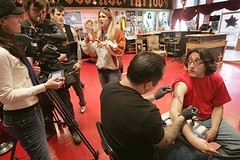 That’s why I was intrigued to see a recent example of how tattooing can be used to express medical self-identity. In an interview in the LA Times Health Section (8 Sept), Joshua Sandoval (MySpace profile here) says he tried to keep his Type 1 diabetes a secret for many years:
That’s why I was intrigued to see a recent example of how tattooing can be used to express medical self-identity. In an interview in the LA Times Health Section (8 Sept), Joshua Sandoval (MySpace profile here) says he tried to keep his Type 1 diabetes a secret for many years:
I realized I still hadn’t accepted the fact I was a diabetic. Sure, I’d dealt with the physical aspects — monitoring my blood glucose levels and giving myself multiple daily insulin shots, eating healthfully, exercising regularly — but I was still keeping the illness private. I still felt abnormal.
But at the age of 22, and to celebrate the 10th anniversary of the diagnosis, Joshua decided “to announce to the world who I am” by having a disease-specific tattoo.
Being “both a writer and a diabetic”, he settled for a quill sticking out of a syringe, a tattoo which would, says the LA Times reporter, “speak to his place in the world”. (Above is Joshua during taping for LA Ink, a reality show that follows the events at the High Voltage Tattoo studio, where also many Hollywood celebrities have their tattoos made.)
Joshua has generously sent us this pic that shows the details of the tattoo:

(credit: Joshua Sandoval)
This very nicely crafted tattoo makes me think of two things. First, it is different from those with a biomedical motif, which we have written about before on this blog. In the case of ‘Therese’, for example, the DNA tattoo is used to announce her professional identity as a biology teacher. In Joshua’s case it goes further — he inscribes both his professional identity (the quill) and his defining biomedical identity (the diabetes syringe) in a joint symbol.
Second, some people may compare this kind of biomedical identity inscription with, for example, the brutal Nazi practice of tattooing Jewish camp prisoners to make their alleged biological/racial identity visible. I don’t think it makes much sense to make such comparisons, however. One is voluntarily and made as a token of self-empowerment; the other was enforced as part of a strategy of de-humanisation and disempowerment.
Has anybody seen similar expressions of biomedical identity image making?
Our own Camilla Mordhorst has been interviewed in the last issue of Riksutställningar’s newsletter (in Swedish). Most exhibitions in cultural history are amazingly traditional, she claims. The Wellcome Collection in London is one of the few which have developed new, exciting narrative techniques, and so has the World Culture Museum in Gothenburg. But otherwise most museums seem to be afraid of experimenting too much. Camilla suggests that museums shall “give visitors a brainstorm instead of a linear time-flow”, a kind of ”additive narration” she calls it. She also points to the problem with invisible curators; facts and artefacts are often presented in a way so that visitors cannot see how they were chosen: “When you cut out the sender you inhibit the language of the exhibition”. Finally, as a curator you don’t have to be subjective, but neither should you pretend to be neutral: “Like a good article, an exhibition has to be argumentative and seductive: it shall be carried forward by statements, either simple or complex”.
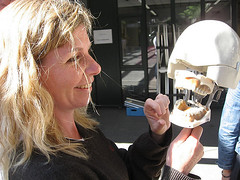 During the medical garbage collecting day in late May, we brought in a number of wonderful and interesting medical artefacts to our collections, including this plastic mannequin from the Department of Odontology (it’s Camilla to the left).
During the medical garbage collecting day in late May, we brought in a number of wonderful and interesting medical artefacts to our collections, including this plastic mannequin from the Department of Odontology (it’s Camilla to the left).
Now Vanessa tells us that Steve Erenburg (a.k.a. radio-guy), a New York based artefact dealer, has this dental mannequin 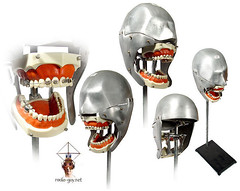 called Dentman — an aluminum head sitting on a cast iron lab stand — for sale for $750!
called Dentman — an aluminum head sitting on a cast iron lab stand — for sale for $750!
Those $750 would have financed the whole medical garbage collection day!
Which gives me an idea. The Ministry of Science in this country wants its universities to engage more in private enterprise. So maybe we should begin to think in terms of collecting medical items for sale!
Actually, as a university museum under the Ministry of Science, Medical Musieon is not formally regulated by the Danish museum law (which is a Ministry of Culture thing). So we could easily begin a two-tiered acquisition strategy. Some artefacts could be collected for lofty heritage reasons, others for the medical antiquities market.
Maybe it’s time to start a Medical Museion Medical Antiquities shop as a PPP (public-private parnership) on the premises here in Bredgade?
The other side of the story is that private dealers in medical antiquities constitute a huge unexplored source of artefacts for medical history museums. The growth of an internet-based medical-historical artefact market is a new situation for our kind of museums. Are medical history museums moving towards a situation like that of art museums, which have always lived in the shadow of private dealers, collectors and galleries? For better or for worse, blogs like Vanessa’s certainly contribute to this tendency.
The Imagine Science Film Festival will be held 16-25 October in New York. The objective of the festival is to showcase films (especially fiction films) that “effectively incorporate science into a compelling narrative while maintaining credible scientific groundings”. The public will join scientists in learning and imagining science through visual storytelling. Films with bio/medical content include ‘A Biometric Tale‘ (2003), ‘In Vivid Detail‘ (2007; about prosopagnosia, i.e., inability to remember faces), and ‘A Fruit Fly in New York‘ (2007). See more here.
Science dancing goes back at least to the classic “Protein Synthesis: An Epic on the Cellular Level” performed at Stanford in 1971. And as the organizers of the 2009 Science Dance Contest say, the human body is an excellent medium for communicating science, “perhaps not as data-rich as a peer-reviewed article, but far more exciting”!
This data-poor but body-rich contest is open to anyone at the postgraduate level in any scientific field and in science-related fields like bioethics, history of science or medicine, etc. — in other words this is a great opportunity for all historians of contemporary biomedicine — and the procedure is quite simple:
- make a video of your own science dance.
- post it on YouTube; and don’t forget to include any relevant information.
- mail the url of your video to: gonzo@aaas.org together with your name, current affiliation and status, the title of your Ph.D., the university where it is earned, and completion date, not later than 16 November.
An independent panel of judges appointed by AAAS/Gonzo Labs will then select a total of four winners from the following categories:
- graduate student: best among those currently enrolled in a Ph.D. program
- post-doc: best among those who have a Ph.D. but not tenure at a university
- professor: best among those with Ph.D. and tenure at a university
- popular choice: the video with the highest YouTube viewcount by the deadline
Note that this is a dance contest, not a video contest, so the judges will focus on the quality of the dance rather than any fancy editing you do. The winning dances will be those that most creatively convey the scientific essence of their respective Ph.D. theses.
The winners will be honored guests at the 2009 annual meeting of the American Association for the Advancement of Science in Chicago in February — and are supposed to work with choreographers and dancers to perform live at the meeting.
 A couple of weeks ago we asked for a guide to restaurants and bars with medical motifs.
A couple of weeks ago we asked for a guide to restaurants and bars with medical motifs.
Øystein Horgmo has kindly sent us an article in the Norwegian daily Dagbladet about the new theme restaurant Hospitalis in Riga, Latvia, which is owned by medical doctors and has a pronounced medical motif.
Says my new favourite guide to Latvian culture, ‘Fucking Latvia: alternative guide to Latvia’:
It is a must-see place if you like gore things. The restaurant looks like a medicine cabinet, while you are treated as a patient and taken good care by the long-legged waitresses in nurses uniforms. The food is served in flasks and operating-room’s dishes and isn’t that cheap (7 and more lats per meal), but this is a bizarre experience that is worth breaking the bank. Besides, the place is owned by local doctors, but unfortunately, the president of Latvia, who is also a doctor, declined his appearance at the opening once he realized how weird this place actually is.
In other words, more raw and bizarre than the utterly sophisticated The Clinic in Singapore. Isn’t there one in Berlin too??
